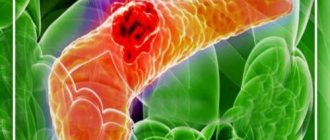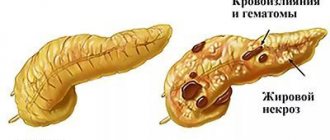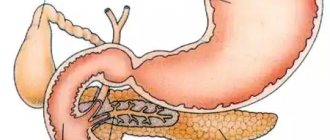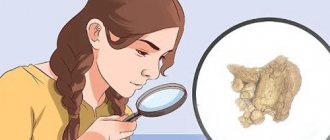Pancreatitis is an acute or chronic inflammation of the pancreas tissue with subsequent disruption of the secretory and endocrine functions of the organ. Most often, the development of pathology is associated with systematic consumption of large amounts of alcohol, smoking, and cholelithiasis.
During an exacerbation of pancreatitis, a person experiences prolonged intense pain in the upper half of the abdomen, his digestion process is disrupted, and yellowness of the skin and mucous membranes may appear.
Treatment includes following a diet, taking medications to facilitate the digestion of food, and painkillers. In some cases, surgery may be required.
According to statistics, in general, the prevalence of the disease does not depend on gender. However, acute alcoholic pancreatitis occurs more often in men, which is associated with a greater addiction to alcoholic beverages among this population group. The disease mainly affects people of working age from 30 to 50 years. In women, the development of pancreatitis is more often caused by gallstone disease.
Causes
The disease can be caused by toxic effects, autoimmune processes, have a hereditary predisposition, or become a complication of gallstone disease.
Alcohol abuse, smoking and obstruction of the bile ducts with gallstones are the most common causes of pancreatitis. In the latter case, the outflow of digestive secretion from the pancreas into the duodenum is disrupted, which leads to its stagnation and “self-digestion” of the organ. The breakdown products of ethyl alcohol have a direct toxic effect on pancreatic cells, as do a number of drugs (estrogens, sulfonamides, tetracycline, erythromycin, thiazides, mercaptopurine). In addition, systematic alcohol abuse is accompanied by thickening of bile, which predisposes to impaired patency of the bile ducts. Nicotine addiction also predisposes to the development of the disease, as it affects the cardiovascular system, causing narrowing of the lumen of blood vessels and a decrease in blood flow to organs.
Damage to the pancreas is also associated with heredity, in particular, it can be genetically determined or caused by congenital developmental anomalies. Autoimmune pancreatitis occurs both alone and in combination with Sjogren's syndrome, inflammatory processes in the intestines and many other autoimmune disorders.
The role of hormones
Insulin and glucagon control blood sugar levels. Insulin ensures the entry of glucose into the cell, stimulates its absorption, and reduces the amount of sugar in the blood.
The main task of glucagon is to prevent hypoglycemia. It increases sugar levels. A-cells in the islets of Langerhans are responsible for production, which also produce lipocaine, which protects the liver from degeneration.
Pancreatic polypeptide produced by PP cells suppresses the secretion of gastric juice. It consists of more than three dozen amino acids that perform secretory functions. Thus, disturbances in the functioning of the pancreas can cause malfunctions and problems in other organs and systems of the body.
Symptoms
Clinical manifestations of the disease are associated not only with damage to the organ itself, but also with a violation of its secretory and endocrine functions. In acute pancreatitis, the symptoms are pronounced:
- Intense pain in the epigastric region, left hypochondrium, local or encircling, often radiating under the left shoulder blade. Unpleasant sensations intensify when lying down and after an error in diet.
- Increased salivation, belching, nausea, frequent vomiting, which does not bring relief.
- Increased body temperature. Fever and chills may occur.
- Changes in skin and mucous color. Moisture and pallor of the skin and moderate yellowing of the sclera are often observed. In rare cases, the skin also takes on a yellowish tint. There may be bluish spots on the body and hemorrhages in the navel area.
- Dyspeptic symptoms – bloating, heartburn.
- Irritability, tearfulness, and in severe cases pancreatogenic psychosis develops.
Chronic pancreatitis is characterized by periods of exacerbation and remission and has a staged course.
In the preclinical stage, there are no symptoms of the disease; changes in the pancreas become an accidental finding during an ultrasound of the abdominal organs. During the period of initial manifestations, multiple episodes of exacerbation of pancreatitis are observed with manifestations characteristic of the acute form of the disease. Gradually, their frequency becomes lower, but symptoms persist during the interictal period: abdominal pain, occasional vomiting, nausea, diarrhea, flatulence. At the stage of persistent symptoms, there is pain in the upper half of the abdomen, often of a girdling nature. The patient loses weight, in particular due to refusal to eat due to fear of increased pain. Manifestations of secretory and endocrine insufficiency, such as indigestion and hyperglycemia, intensify.
Subsequently, pancreatic atrophy occurs. The pain may become less intense or absent, and the frequency of attacks of pancreatitis is reduced. The feces become mushy, foul-smelling, and greasy. Exhaustion is observed, and pancreatogenic diabetes mellitus develops. In the last stage, systemic complications arise, and malignant degeneration of the tissue of the affected organ is possible.
Complications
Depending on the form, severity and stage of the disease, the risk of developing certain complications of pancreatitis increases.
With a progressive long-term course of the pathology, disturbances in the outflow of bile with subsequent obstructive jaundice, the formation of an abscess, cysts, the development of portal hypertension, pancreatogenic diabetes mellitus, parapancreatitis, “enzymatic” cholecystitis, pneumonia, exudative pleurisy, paranephritis, and pancreatic cancer are possible. The consequences of an acute process can be:
- peritonitis;
- septic phlegmon of retroperitoneal tissue;
- arrosive bleeding in the digestive tract, hemorrhage into the abdominal cavity;
- obstructive jaundice;
- ascites;
- formation of internal and external digestive fistulas, abscesses and infiltrates.
In severe cases, shock and multiple organ failure with a high risk of death may develop.
Role and functions of the pancreas
The pancreas provides several functions at once: the production of hormones and digestive enzymes. It is an exocrine and intrasecretory gland.
The pancreas produces hormones that ensure the breakdown of fatty acids necessary for the functioning of the kidneys, heart, and muscles. The pancreas is also responsible for the production of hormones that regulate sugar levels (insulin, glucagon). It releases ghrelin, which is responsible for the urge to eat. Provides participation in metabolic processes: fat, carbohydrate, protein.
The pancreas is also responsible for the production of enzymes necessary for digestion. The key task of enzymes is the metabolism of carbohydrates, proteins, and fats.
If one function fails, the others remain normal, thanks to the division into different sections responsible for the production of enzymes/hormones. Thus, in diabetes mellitus there are no digestive disorders, and previous inflammation of the organ does not necessarily cause persistent hypoglycemia. However, it is important to understand that pathological changes in the organ can negatively affect the body’s energy supply and carbohydrate-fat metabolism.
Diagnostics
The identification and treatment of pancreatitis is carried out by a general practitioner and gastroenterologist together with an endocrinologist, surgeon and other specialists.
Often, patients with an acute form of the disease are taken by emergency medical care to a surgical hospital, where a differential diagnosis of pancreatic damage with acute appendicitis, cholecystitis and other pathologies is carried out. After clarifying the complaints, collecting an anamnesis, including dietary patterns, bad habits, frequency of relapses, concomitant diseases of the biliary system, and examination, the doctor refers the patient for tests, as well as instrumental studies.
As part of the laboratory examination of the patient, the following is carried out:
- General clinical blood test. There are signs of inflammation: acceleration of ESR, leukocytosis.
- Biochemistry of blood. Damage to the pancreas during pancreatitis is characterized by increased activity of enzymes (amylase, lipase), possible hyperglycemia, hypoalbuminemia and hypocalcemia, bilirubinemia, as well as increased activity of liver enzymes (ALT, AST, transaminases), CRP.
- Biochemical examination of urine. It is carried out to determine amylase activity in urine.
- Coprogram. Steatorrhea is characteristic.
- Determination of pancreatic elastase in feces.
Instrumental diagnosis of pancreatitis includes:
- Ultrasound of the abdominal organs is a method of visualizing the gland itself and surrounding organs;
- SCT and MRI of internal organs to obtain more detailed information about anatomical changes in them;
- endoscopic retrograde cholangiopancreatography for the purpose of visualizing the lumen of the ducts, taking pancreatic secretions, removing stones;
- endoscopic elastography of the pancreas - allows you to determine the rigidity and rigidity of the tissue, assess the degree of its connective tissue replacement and the secretory function of the organ;
- esophagogastroduodenoscopy to assess the condition of the hollow digestive organs.
Pancreatitis
Pain as one of the main symptoms of pancreatic disease
One of the most common diseases of this organ is pancreatitis. Pancreatitis is a fairly severe inflammation of all tissues of the pancreas. There are two forms of pancreatitis - acute and chronic. The following signs and symptoms are characteristic of the acute form of pancreatitis:
Treatment
You should seek medical help at the first signs of pancreatitis, then the chance of avoiding complications and the disease becoming chronic will be higher.
During an exacerbation of the disease, fasting is recommended. All patients suffering from pancreatitis must follow a diet and give up alcohol and smoking. During the interictal period, you should eat small portions several times a day, including in your diet mainly foods high in proteins and complex carbohydrates, dietary fiber, and vitamins.
Drug therapy involves taking drugs from the following groups:
- analgesics for pain relief in pancreatitis;
- pancreatic enzymes;
- inhibitors of hydrochloric acid secretion in the stomach;
- sedatives and antidepressants;
- antibiotics;
- insulin;
- vitamins
In case of complicated course of the disease, as well as in some cases of acute abdominal pain, endoscopic or surgical intervention is indicated.
How does the pancreas work?
The components of the pancreas are the islets of Langerhans. They consist of cells that produce hormones:
- delta cells - produce somatostatin, gastrin and ghrelin;
- beta cells - ensure the production of insulin;
- a-cells - produce glucagon;
- PP cells produce pancreatic polypeptide.
Proinsulin protein is synthesized in beta cells. When the C-peptide molecules are separated, it is converted into insulin. The part that is not synthesized enters the blood unchanged. Insulin is required by the body to transport glucose, which is the main source of energy. It is also responsible for the delivery of amino acids and potassium to cells. It itself is not able to penetrate the cell, but can affect its receptors. Insufficient insulin production occurs when beta cells are damaged. As a result, a person develops type 1 diabetes mellitus. If the process of glucose penetration into the cell is disrupted, type 2 diabetes is diagnosed. In this case, there is enough insulin in the blood, but the cells do not recognize it. In the first and second cases, glucose accumulates, which cannot be transported into cells, resulting in hyperglycemia. An excess of insulin secretion leads to the formation of insulinoma.
Glucagon (an insulin antagonist) is produced by the a-cells of the pancreas. When its level increases, the body receives a signal about the need for glucose. This is achieved by the transformation of glycogen to produce glucose or its formation through gluconeogenesis.
Gastrin is responsible for stimulating gastric secretion. Its concentration level changes throughout the day. It almost doubles after eating food. Production occurs when the level of hydrochloric acid in the stomach drops. Samostatin has an effect on the digestive system by suppressing the production of hormones (glucagon, gastrin, insulin) and enzymes. Able to suppress the secretion of other gastrointestinal organs.
Prevention
Primary prevention of pancreatitis is to avoid alcohol, eat a variety of foods that are low in fat, saturated fat and cholesterol, include grains, vegetables and fruits in the diet, and stop smoking.
Acute pancreatitis can develop not only in people who regularly abuse alcohol, but also as a result of a single intake of alcohol-containing drinks with a fatty, fried and spicy snack in large quantities. Small, proper nutrition for pancreatitis serves to prevent exacerbations of its chronic form.









